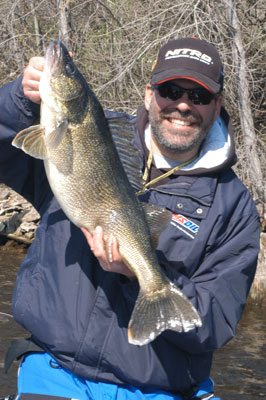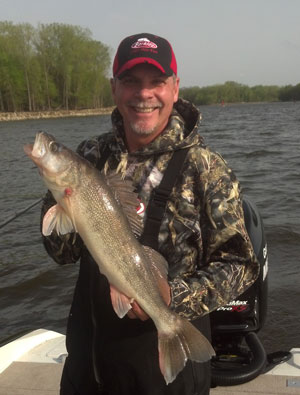As winter approaches, those of us that chase walleyes across the northern range are beginning to get a sense of just how limited our open water fishing opportunities are these days. Some have already changed focus from fishing to hunting pursuits, but there are many of us that choose to hang on to these last few chances remaining at good angling opportunities right to the bitterly cold end. For some, it’s the chance to have their favorite lake virtually all to themselves, while others are on the hunt for their last true trophy of the season. Whatever your motivation, there is still plenty of great fishing left before ice fishing takes center stage. But even though the “fall feeding frenzy” has tapered off and the fish are beginning to settle down for a long winter, the walleyes are still catchable. It’s just going to take a bit of finesse.
Keith Kavajecz and Gary Parsons
 As winter approaches, those of us that chase walleyes across the northern range are beginning to get a sense of just how limited our open water fishing opportunities are these days. Some have already changed focus from fishing to hunting pursuits, but there are many of us that choose to hang on to these last few chances remaining at good angling opportunities right to the bitterly cold end. For some, it’s the chance to have their favorite lake virtually all to themselves, while others are on the hunt for their last true trophy of the season. Whatever your motivation, there is still plenty of great fishing left before ice fishing takes center stage. But even though the “fall feeding frenzy” has tapered off and the fish are beginning to settle down for a long winter, the walleyes are still catchable. It’s just going to take a bit of finesse.
As winter approaches, those of us that chase walleyes across the northern range are beginning to get a sense of just how limited our open water fishing opportunities are these days. Some have already changed focus from fishing to hunting pursuits, but there are many of us that choose to hang on to these last few chances remaining at good angling opportunities right to the bitterly cold end. For some, it’s the chance to have their favorite lake virtually all to themselves, while others are on the hunt for their last true trophy of the season. Whatever your motivation, there is still plenty of great fishing left before ice fishing takes center stage. But even though the “fall feeding frenzy” has tapered off and the fish are beginning to settle down for a long winter, the walleyes are still catchable. It’s just going to take a bit of finesse.
When it comes to walleye fishing, two of the most time tested finesse presentations for catching fish are live bait rigging and jigging. Many anglers see these two presentations as being almost interchangeable. Both presentations share a few key points such as: each incorporates a weight, a hook and bait, each is a “feel” technique demanding sensitive equipment and an educated touch, and both methods are great ways to catch fish. However, in the “real” walleye world, these two set ups are best utilized under quite different fishing situations.
Rigging:
Basically the live bait rig (or “rig” for short) involves a sliding sinker on the “main” line, a swivel connected to a leader and a hook baited with live bait, be that a minnow, leech or a night crawler. It’s a presentation that puts your offering in front of a walleye’s nose and allows the bait’s natural action to trigger the fish to bite.
This is not a technique one uses to cover water, but rather a technique for targeting walleyes that are congregated on specific structures. Rigging is best utilized when walleyes become finicky due to a drop in water temperature, fishing pressure or any other reason that has them “off the bite”. Under such conditions walleyes don’t move around much and neither should you. A rig is a good choice under the toughest angling situations.
The rig is best fished on light to medium light spinning tackle. Fish it fairly vertical below the boat with the bail open and the index finger of your “rod” hand holding the line. When you feel a bite, allow a few feet of slack in the line by releasing it from your finger (this lets the fish take the bait without feeling resistance). Move the boat over the fish and start reeling up the slack until you feel the fish on the line. Now don’t go setting the hook like you see the bass guys do on TV. Instead, continue reeling and lean back with the rod to set the hook. The continuous pressure will drive the hook home.
Jigging:
Jigging uses a jig tipped with bait and/or some other attractor such as an artificial tail. Unlike rigging where the bait’s natural movement provides most of the action; in jigging the angler imparts the action that triggers the fish. This makes jigging very versatile as you can use a wide variety of jigging motions from very aggressive “popping” actions to ultra subtle “dragging” techniques.
Jigging is more of a search method that works any time fish are a little more active or spread out. Cast jigs to probe likely shallow areas, vertically jig in rivers as the current sweeps you along or slow-troll a jig, covering deeper water contours in a lake or reservoir.
Unlike rigging, as soon as you feel a bite when jigging, set the hook immediately. If using no-stretch lines, such as Berkley FireLine, make sure the reel’s drag gives a little on the hook set to avoid tearing the jig from the fish’s mouth.
Since you’re imparting the action to the jig, live bait isn’t always necessary. Using artificial tails, such as a Berkley GULP! Minnow or a Berkley PowerBait Rib Worm will add not only action but also scent to the presentation. Artificials stay on the hook better than live bait especially when fishing in snaggy areas or when using an aggressive jigging motion.
Gear up for Rigging and Jigging:
For rigging, a 6 1/2 to 7 foot rod with a medium to medium light action is preferred. The softer action lets the rod give a little bit when a fish first gets the bait in its mouth, a nd aids in fighting the fish on light line. A high quality, sensitive rod also lets you feel the sinker bouncing along the bottom and detect bites immediately. For several years now we have been working with Bass Pro Shops on the design of the Walleye Angler Signature Series Rods and the ones specifically designed for these tactics are among the finest anywhere. For live bait rigging, the top choice would have to be the model # WA70MS-HM85, a medium action seven foot spinning rod made of high-modulus HM-85 graphite.
nd aids in fighting the fish on light line. A high quality, sensitive rod also lets you feel the sinker bouncing along the bottom and detect bites immediately. For several years now we have been working with Bass Pro Shops on the design of the Walleye Angler Signature Series Rods and the ones specifically designed for these tactics are among the finest anywhere. For live bait rigging, the top choice would have to be the model # WA70MS-HM85, a medium action seven foot spinning rod made of high-modulus HM-85 graphite.
For jigging, a 6 foot spinning rod with a medium to medium light action is typically preferred. The Walleye Angler Signature series model # WA60ML-HM85 is a six foot medium action stick that rivals jigging rods costing twice as much. Both rigging and jigging rods should feature good backbone for solid hook ups and a softer tip section to help act as a shock absorber in hook setting and fighting fish.
Light line is critical to walleye rigging and jigging presentations. Whether you like the no-stretch sensitivity of Berkley FireLine, the time tested dependability of a mono like Berkley Sensation, or even the stealthy characteristics of a fluorocarbon line like Berkley Trilene 100% Fluorocarbon, line in the 4 to 8 pound test range are, hands down, the choices to get the job done.
Using the right hook on your rig can make a difference in the number of fish you catch. A good, sharp, light wire hook will ensure hook ups as well as allow the bait to swim more freely, adding to the attraction. Yet you need a hook with a strong point to withstand being dragged through rocks and other cover along the bottom. Our top choice here is the Mustad Double Wide Fine Wire Livebait hook (model 10548R). The wide gap means you’ll get better hook-ups, and the red finish adds just a little extra attraction to the offering.
Summary:
Rigging and jigging share many similarities when it comes to walleye fishing yet each serves a very different purpose. We have only touched the surface when it comes to explaining these presentations, but as you learn more about when to rig and when to jig, you’ll see for yourself why both are top walleye tactics for getting you the Next Bite in late fall.










